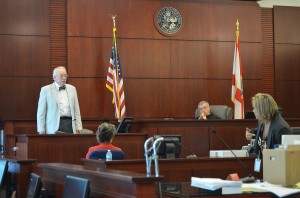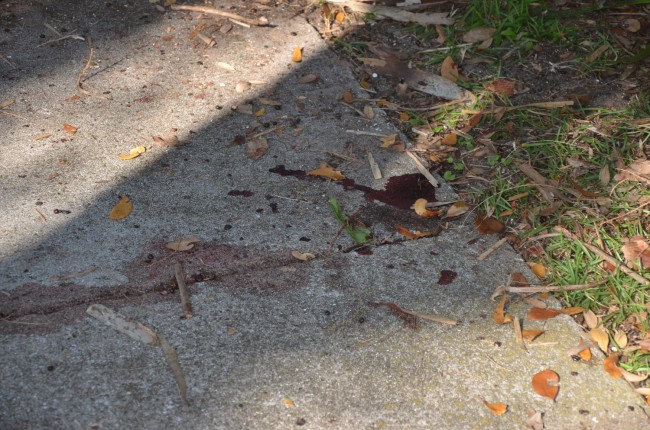
Paul Miller’s defense team rested its case just past noon today, but closing arguments will take place Friday morning. Only then will the jury deliberate. A verdict is likely sometime Friday.
That left Thursday to be an anticlimactic pause in the four-day trial after the defense’s last two witnesses—from an abbreviated list of barely half a dozen—focused the jury’s attention on two details: the fact that Miller’s property line actually went a few grass blades past his 4-foot fence, into what until now had been assumed to be Dana Mulhall’s property. And on a pathologist-for-hire’s interpretation of the five-bullet sequence that killed Mulhall that March day in 2012, as Miller and Mulhall were arguing over Miller’s barking dogs.
Mulhall and Miller lived next to each other on the west side of South Flagler Avenue in Flagler Beach, at 1340 (Miller) and 1336, a neighborhood of close-cropped homes with a mixture of retirees and children.
The defense hired Dan Wilcox, the surveyor, to delineate precisely where the two neighbors’ property lines began and ended. A photograph shown the jury showed, in a distinct orange line, that Miller had lined his four-foot separation plastic fence just inside his property line. Miller repeatedly noted how Mulhall had been grabbing the fence at the time of the confrontation, shaking it, and looked as if he might climb over it. By showing that orange line, the defense could now claim that Mulhall did not remain on his property in the strictest sense, dampening one of the prosecution’s points: that Mulhall, while upset at the dogs, had remained on his side of the line throughout.
The pathologist the defense flew in (he landed at Jacksonville airport at 9:30 this morning, and was in court in late morning) is the quirky Ronald Wright, whose history in Florida is as long as his trademark bow-ties can be colorful. The prosecution did not keep that history silent.
Between one tangent and another—Wright is fond of making his points by way of esoteric digressions that can go as far as describing the way alcohol was used as an anesthetic during the Civil War or pointing out that he, too, was once shot—Wright also gave his interpretation of alcohol’s effects on a human body. That effect can be so numbing that, even when being shot, a person could possibly feel nothing.

(© FlaglerLive)
There is no disagreement between the prosecution’s pathologist (Chief Medical Examiner Predag Bulic of the 7th Judicial Circuit, which includes Flagler County) and Wright over Mulhall’s elevated alcohol tolerance level. But nor did the defense make an issue of Mulhall’s alcohol consumption that day as impairing his mobility so much as his behavior, including how he fell when he was being shot: the prosecution argues that he was running away from Miller when the shooting began. The defense’s pathologist today said the angle of the first shots were consistent with someone “running, climbing fences, whatever.” Dropping that detail about “climbing fences” was key for the defense, which wants to show that Mulhall may have been charging Miller.

(© FlaglerLive)
The prosecution underscored such disparities, calling Wright’s interpretation of the bullet sequence an opinion. The prosecution also sought to discredit Wright’s background by bringing up his history as a pathologist. He last worked as a medical examiner in 1994, when then-Gov. Lawton Chiles declined to reappoint him to his post in South Florida. Weright today said it was a political decision for which he never got an explanation. He filed a motion to, according to him, ensure that such appointments were not politicized. The motion was filed with the Florida Supreme Court, which upheld Chiles’s decision.
Wright’s departure from the Broward County Medical Examiner’s office was quite controversial. “After 13 years as the eccentric keeper of Broward’s morgue” the Sun-Sentinel had reported in 1994, “Wright was brought down by a campaign by lawyers who accused him of botching cause-of-death cases, and by opposition from county officials who disliked his handling of the office” Two lawyers had begin the campaign against Wright, accusing him of “making questionable cause-of-death decisions in lawsuits they were handling.”
“This was not a vendetta against Wright,” the paper had quoted one of the lawyers as saying. “There were significant problems in his office, what we perceived to be an attempt to sway cases based on unscientific facts.” Wright’s response: “I don’t think the folks involved were very truthful.”
Today, Wright is a self-employed forensic pathologist who divides his time between Fort Lauderdale and Tennessee, charging $500 an hour for trial testimony and $4,000 to analyze an autopsy report—such as the printed report by Bulic he was provided, and on which he relied to provide his testimony today. Assistant State Attorney Jacquelyn Roys asked him if he was getting paid, but not how much: defense and prosecution attorneys routinely use paid expert witnesses.
Prosecution and defense tangled over Wright’s testimony regarding Mulhall’s position at the time of the shooting: whether he was bent over, to what extent was he bent over, what that might mean—was he running away from Miller, toward him, toward his house (the previous day’s forensic analysis had shown him moving from roughly the middle of the yard, near the Miller fence, toward Mulhall’s front door).
Witnesses gone and jury recessed until Friday, the two sides then spent 90 minutes Thursday afternoon arguing over the detailed jury instructions Circuit Judge J. David Walsh, who’s been presiding over the trial, will deliver Friday. Instructions are long, detailed and often arcane sounding, but they define the parameters within which a jury may render a verdict. What those parameters consist of is set in law, but it also depends on the interpretation of those laws.






























notasenior says
This is another case of a mentally unstable person with a gun. Miller has no remorse for what he did and thus should never be released from prison.